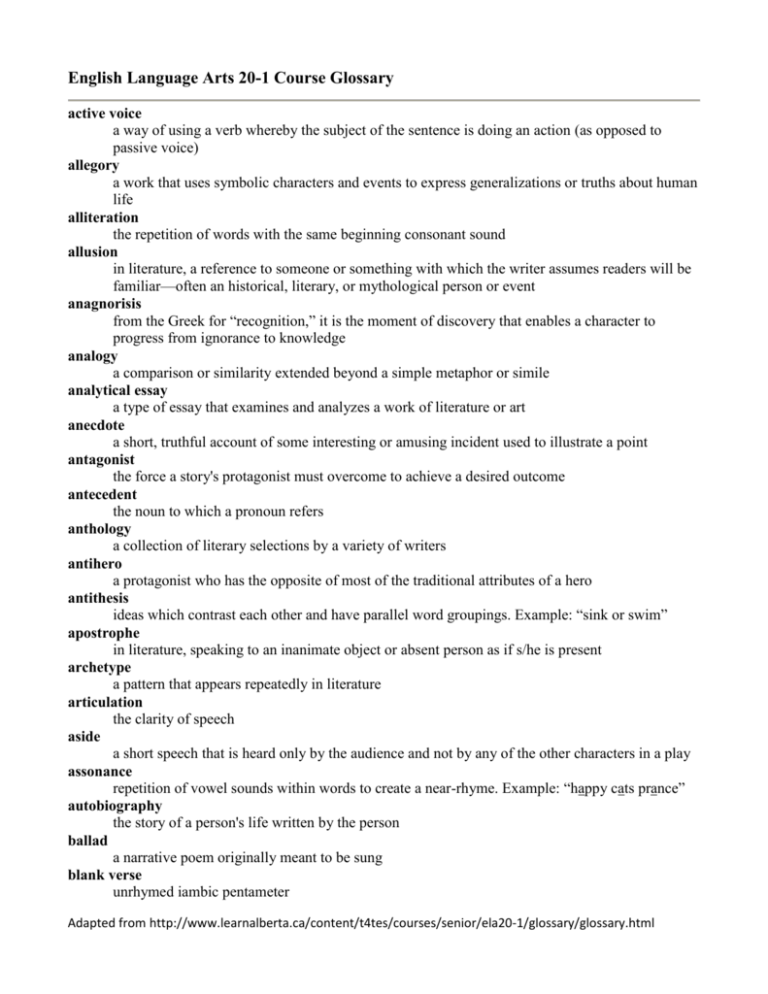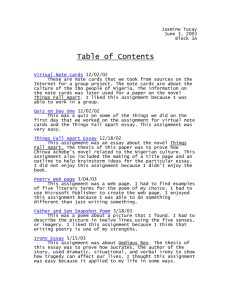English Language Arts 20-1 Course Glossary active voice a way of
advertisement

English Language Arts 20-1 Course Glossary active voice a way of using a verb whereby the subject of the sentence is doing an action (as opposed to passive voice) allegory a work that uses symbolic characters and events to express generalizations or truths about human life alliteration the repetition of words with the same beginning consonant sound allusion in literature, a reference to someone or something with which the writer assumes readers will be familiar—often an historical, literary, or mythological person or event anagnorisis from the Greek for “recognition,” it is the moment of discovery that enables a character to progress from ignorance to knowledge analogy a comparison or similarity extended beyond a simple metaphor or simile analytical essay a type of essay that examines and analyzes a work of literature or art anecdote a short, truthful account of some interesting or amusing incident used to illustrate a point antagonist the force a story's protagonist must overcome to achieve a desired outcome antecedent the noun to which a pronoun refers anthology a collection of literary selections by a variety of writers antihero a protagonist who has the opposite of most of the traditional attributes of a hero antithesis ideas which contrast each other and have parallel word groupings. Example: “sink or swim” apostrophe in literature, speaking to an inanimate object or absent person as if s/he is present archetype a pattern that appears repeatedly in literature articulation the clarity of speech aside a short speech that is heard only by the audience and not by any of the other characters in a play assonance repetition of vowel sounds within words to create a near-rhyme. Example: “happy cats prance” autobiography the story of a person's life written by the person ballad a narrative poem originally meant to be sung blank verse unrhymed iambic pentameter Adapted from http://www.learnalberta.ca/content/t4tes/courses/senior/ela20-1/glossary/glossary.html brainstorming generating as many ideas as possible without restraint or criticism cacophony the use of harsh sounds in literary composition catharsis meaning “purgation”; purification by way of an emotional release cite quote or refer to as an example cliché an overused expression coherence in writing, the clear connection of ideas and details colloquial ordinary, conversational language comic relief humour designed to ease the tension in an otherwise serious context composition in visual communication, the arrangement of the subject matter conflict in literature, the struggle between the protagonist and an opposing force connotation the implied meaning of a word consonance the repetition of consonant sounds within words. Example: “his fist struck the stage” context the time, situation, environment, and set of circumstances in which an event occurs contrast highlights the differences between or among things coordinating conjunction a word used to join words or groups of words: are and, or, nor, for, but, so, yet couplet in poetry, two consecutive rhyming lines written in the same metre deductive reasoning a method of reasoning that begins with a theory or general principle which is then applied to particular cases denotation the literal meaning of a word descriptive essay a type of essay in which the author describes some person, event, etc. in significant detail dialogue conversation diction choice of words and level of language dilemma a situation in which a person must choose between two equally unsatisfactory alternatives dissonance a mingling or union of harsh, inharmonious sounds which are grating to the ear Adapted from http://www.learnalberta.ca/content/t4tes/courses/senior/ela20-1/glossary/glossary.html dramatic irony a form of irony in which there is a difference between what the audience knows and what a character believes to be true editorial end rhyme rhyme occurring in the final syllables of two or more lines of poetry enjambment when one line of poetry continues into the next line without a pause epic an extended narrative poem, usually about a hero euphony the use of harmonious-sounding words exposition part of a work of fiction that introduces characters and provides background information expository essay a type of essay, the purpose of which is to explain a topic or issue. external conflict a problem or struggle between a person and a physical force (person-versus-environment conflict) or between people (person-versus-person conflict) flashback a narrative technique whereby a writer breaks off the narration to relate preceding events foil a character with a personality trait that strongly contrasts a trait of another character foot in poetry, a unit usually consisting of one stressed syllable and one or two unstressed syllables foreground in a visual representation, the objects nearest the viewer formal foreshadowing the providing of hints about events that will occur later in a story free verse poetry without a fixed rhyme scheme or metrical pattern hamartia “some error or frailty” that brings about misfortune for the tragic hero (Aristotle) homonym a word that has the same pronunciation as another word but a different spelling and meaning hubris excessive pride or self-confidence that leads a protagonist to violate an important moral law hyperbole the use of exaggeration iambic pentameter consists of five iambic feet per line. An iamb consists of an unstressed syllable followed by a stressed syllable. imagery words used to paint pictures or appeal to the senses of the reader or listener independent clause a clause that can stand as a sentence on its own inductive reasoning a method of reasoning that involves an examination of individual instances or examples and the subsequent development of a theory or general principle about them Adapted from http://www.learnalberta.ca/content/t4tes/courses/senior/ela20-1/glossary/glossary.html inference a conclusion made by weighing evidence inflection change in pitch and volume interjection a word expressing emotion or surprise internal conflict a mental or moral dilemma or struggle (also known as a person-versus-self conflict) juxtaposition the act of positioning two things next to each other for effect key-word strategy a way of linking ideas in an essay or report by selecting a key word or phrase from the thesis statement and repeating the word at the beginning of other paragraphs litotes a statement is expressed by denying its opposite medium a means through which a message is communicated memoir a record of a person's experiences metaphor a comparison between two unlike things without using the words like or as metre the number of feet (or stressed syllables) in a line of poetry monologue a single speaker reveals his or her character by addressing an implied audience monotone a tone of voice that lacks expression and variety of intonation mood the pervasive feeling or impression produced by a text motif a recurring theme or image narrative essay an essay that relies mainly on narration (storytelling) to make its point narrator the person telling a story. First person narrators are characters within the story. Third person narrators are not characters. Third person narrators can be further categorized as omniscient (allknowing), limited-omniscient (knowing the thoughts of only one character) or objective (without knowledge of the thoughts or feelings of any characters). non-fiction deals with information and facts octave a group of eight lines of poetry ode a poem addressed to a praised person or object onomatopoeia the use of words that imitate the sound represented by the word oxymoron the juxtaposition of two contradictory words Adapted from http://www.learnalberta.ca/content/t4tes/courses/senior/ela20-1/glossary/glossary.html pace the speed at which a presentation is made paradox a situation or statement that appears to be contradictory or inconsistent yet is, in fact, not parallelism the repeated use of the same grammatical form or structure parody satirizes someone or something by imitating it passive voice a way of using a verb whereby the subject of the sentence is receiving an action pathetic fallacy involves the personification of nature which is portrayed as being emotionally sensitive peripeteia a reversal of fortune for the protagonist of a literary work personal essay a type of essay that presents the author’s personal opinions but does not necessarily attempt to persuade the reader of anything personification the assigning of human qualities to non-human subjects persuasive essay a type of essay, the purpose of which is to persuade the reader to adopt the author’s perspective. Some people differentiate between persuasive and argumentative essays, claiming that persuasive essays appeal to the reader’s emotions, while argumentative essays appeal to reason through facts and logical arguments plagiarize to use an author's words or ideas without acknowledgement primary source an original source of information such as a person who has direct knowledge of an event or an experience projection the degree to which a speaker's voice carries propaganda beliefs and ideas deliberately spread, often by distortion and deception, to further a cause protagonist the main character who has a goal to achieve pun a play on words that relies on a word having more than one meaning purpose what an author hopes to accomplish through his/her writing quatrain a group of four lines of poetry revising in writing, the process of revisiting and reworking the content and organization of an earlier draft rhetorical question a question that is asked for effect and does not expect a response rising action the part of a work of fiction that builds tension and leads up to the climax of the plot Adapted from http://www.learnalberta.ca/content/t4tes/courses/senior/ela20-1/glossary/glossary.html satire in literature, the ridiculing of human vice or stupidity in order to expose and correct it sestet a group of six lines of poetry simile a comparison between two unlike things using the words like or as situational irony a form of irony in which what happens is not consistent with what one would expect slang the current colloquial expressions used by a group of people slant a bias or a personal viewpoint that colours the way a story is written soliloquy a speech given by a character alone on stage expressing his or her thoughts and feelings sonnet a fourteen-line poem with a fixed rhyme scheme standard stanza lines in a poem that have been grouped together for effect style a person's individual manner of expression subordinating conjunction a word that joins a dependent clause to an independent clause symbol something that stands for, or represents, something else synonyms words having the same, or very similar, meanings tercet a stanza composed of three lines theme the central idea or insight about life that emerges from a piece of literature thesis the main argument of a writer or speaker; the central point he or she wants to make tone an attitude reflected in word choices, sentence structures, and emphasis tragedy in traditional drama, a serious play that usually involves the downfall of a great and/or good person because of some fatal flaw in his or her character tragic hero a person of stature who possesses a character flaw which ultimately leads to his downfall; he is not a victim of fate. Usually, before his death, a tragic hero accepts responsibility for his actions understatement the opposite of hyperbole verbal irony a form of irony in which the implicit meaning of a speaker differs from the explicit message voice in writing, the personal and recognizable style of a writer voice-over the voice of an unseen narrator on a TV show or in a movie Adapted from http://www.learnalberta.ca/content/t4tes/courses/senior/ela20-1/glossary/glossary.html


